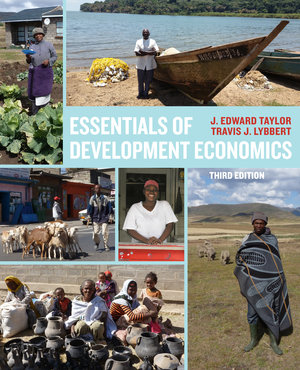By J. Edward Taylor and Travis J. Lybbert, co-authors of Essentials of Development Economics, Third Edition
This post is part of our #ASSA2021 blog series. Learn more at our virtual conference exhibit.
Between the two of us, we have taught upper division development economics to thousands of undergraduates across many majors and over a number of decades (more than Ed, in particular, cares to think about!). We have also taught more advanced MS and PhD courses in development economics that build on the same foundational concepts – that is, the same essentials.
Our approach to teaching development economics has evolved over time, and not just as we gained experience and received feedback from students and teaching assistants. It’s also been shaped by the distinct research shift in the field towards empirical and experimental methods that emphasize causal inference. In this sense, the book represents what we believe to be the most efficient and effective way to teach development economics in an era when both the field and the students we teach are different than they were before.
Several features of Essentials of Development Economics, Third Edition distinguish it from other introductory textbooks in development economics, but one may stand out more than any other: The desire to connect students to the frontiers of development economics research in ways that both inspire and instruct.
With this in mind, we adopt an unconventional chapter structure that leads with a detailed, mostly non-technical exposition on causal identification and the problem of selection bias in Chapter 2 (following a broad and historical introduction to the field in Chapter 1).This chapter, called “What Works and What Doesn’t,” introduces RCTs as a dominant empirical methodology in development economics, but also covers other methods economists use when RCTs are not feasible or logically (or ethically) possible. While randomization can indeed be potent when it is the right “tool in the shed,” we’ve found that it’s important to also introduce students to the tradeoffs researchers face when designing research studies. This means exposing them to some of the other tools at researchers’ disposal.
In our experience, leading with this introduction to impact evaluation and causality benefits students in at least three key ways.
First and foremost, it sets the stage for idealized thought experiments and for engaging students with widely cited and well-known articles as sidebars throughout the text. This opens new doors for students to understand and appreciate the essentials of the field by giving them access to concrete and policy-relevant research.
Relatedly, we find that helping students connect with the frontiers of development economics makes the field come alive in new ways. Many upper division undergraduates are anxious or excited (often both) about their career prospects. Presenting the essentials of development economics from the perspective of practitioners and researchers in the field – giving them glimpses of the “room where it happens” – often resonates well with students. Even those set on very different careers appreciate this more personal and professional connection with the field.
Finally, development economics – like much of economics more broadly – is about tradeoffs. These tradeoffs apply to development policy, economic growth or entrepreneurship and innovation, but they also apply to how we do applied research. Chapter 2 helps to make clearer and more concrete this second methodological dimension of tradeoffs: Students learn to appreciate the power of RCTs, while also comprehending their limitations.
Speaking of tradeoffs, the unconventional structure of this book raises some of its own. Specifically, devoting a week early in the quarter or semester to Chapter 2 and impact evaluation comes at an opportunity cost, but in our experience, this is an investment that pays off by enabling deeper coverage of the later chapters of the book.
Embracing this pedagogy also entails a bit more effort on the part of the instructor, which is why the textbook is distinctly less ‘plug-and-play’ than other introductory development economics texts. But in our decades of experience with thousands of students, the additional effort to connect students to the frontiers of the field comes with the high reward of deeper student engagement.




